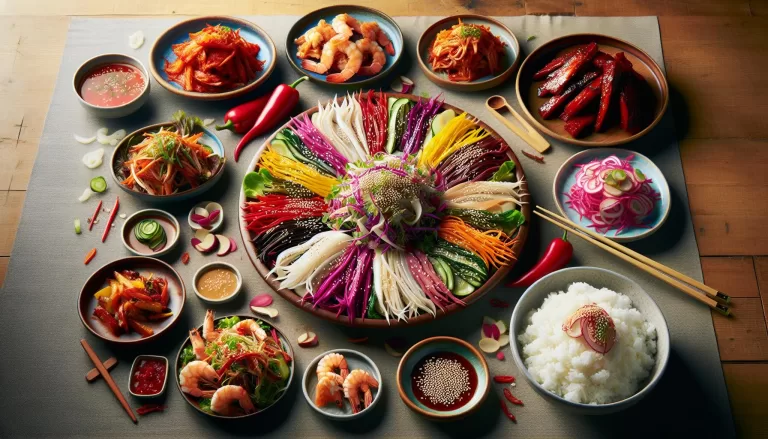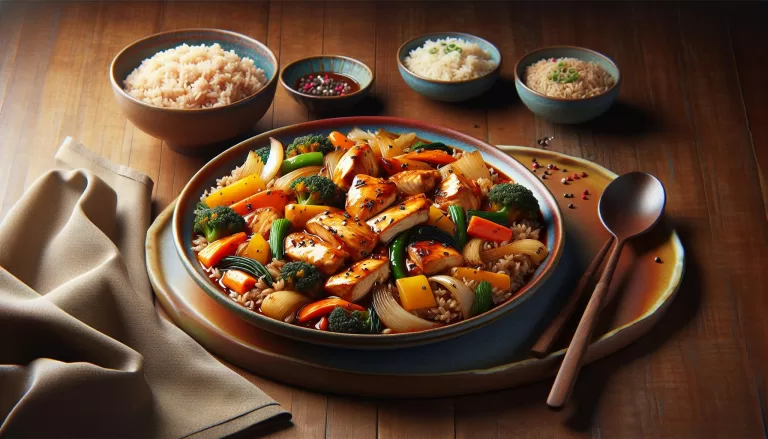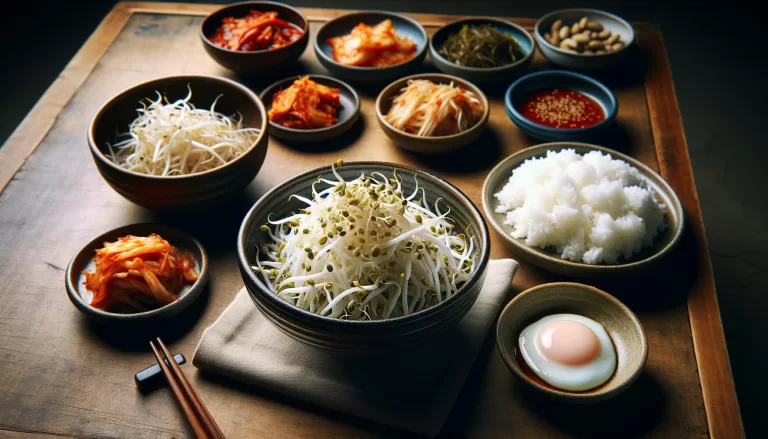Boost Your Health with This Homemade Dakjuk Korean Chicken Porridge Recipe

Ingredients for Homemade Dakjuk Korean Chicken Porridge
Let’s dive right into what you’ll need. To prepare this comforting dish at home, gather the following essentials:
- 1 whole chicken
- 1 cup of sticky rice
- 8 cups of water
- 1 tablespoon of minced garlic
- Salt to taste
It’s a simple list, right? That’s one of the marvels of Dakjuk – its complexity arises not from an extensive ingredient list, but from the thoughtful preparation method. The core components are straightforward: chicken, rice, and water, while garlic adds an aromatic kick. Salt tailors your Dakjuk to your taste buds.
If you’re feeling adventurous, consider these unconventional tweaks. They’re optional but can inject a burst of flavor:
- Soy sauce: A drizzle of this condiment adds depth and umami.
- Sesame oil: Just a splash provides a roasted, nutty tang.
- Ginger: A little of this root can brighten and refresh your porridge.
Let’s dive into the nutritional facts of your meal. Take a look at this handy markdown table:
| Ingredient | Calories | Carbs | Protein | Fat |
|---|---|---|---|---|
| Whole Chicken | 1400 | 0 | 231 | 94 |
| Sticky Rice | 166 | 36 | 3.6 | 0 |
| Garlic | 4 | 1 | 0.2 | 0 |
So, what are you waiting for? Roll up your sleeves, gather your ingredients, and let’s get cooking! No worries if you don’t have a few items; feel free to experiment with these tasty alternatives. After all, one of the joys of home cooking is making a dish truly your own.
Step-by-step Instructions for Making Dakjuk

Now that you’re familiar with the ingredients, let’s dive into the actual process of making Dakjuk. Use this clear, easy-to-follow guide and you’ll be able to cook up this delectable dish at home. Feel free to bookmark this page for easy reference as you step into your kitchen.
- Rinse 1 cup of sticky rice under cold water until it runs clear. This helps to remove excess starch, preventing the grains from sticking together too much.
- Place the rinsed rice and 8 cups of water in a large pot and bring it to a boil. Once you’ve got a rolling boil, reduce the heat to low and allow that to simmer for about 40 minutes. This forms the base of your porridge.
- While the rice is simmering, start prepping your chicken. You’ll need 1 pound of boneless chicken for this recipe. Cut it into small, bite-sized pieces, and season them with kosher salt and crushed garlic. Many recipes call for just salt, but garlic adds an extra layer of flavor that enhances your Dakjuk.
- After the rice has simmered for 40 minutes, add your seasoned chicken to the pot. Let that cook for another 20 minutes. Be sure to stir frequently as it cooks, as this helps to break the rice and chicken down into a porridge consistency.
- Looking to give your Dakjuk a unique twist? Try adding a teaspoon of freshly grated ginger, a condiment not often seen in traditional Dakjuk recipes. The zing from the ginger not only differentiates your Dakjuk, but it’s also great for providing some warmth during the chilly seasons.
- Once you’ve added the chicken and any extra flavors, let everything simmer until the chicken is fully cooked and the rice has broken down fully. The final product should have a creamy, soup-like consistency. Remember, Dakjuk isn’t about speed; it’s about the joy and art of cooking.
There you have it. You are now armed with all you need to prepare your very own batch of comforting, homemade Dakjuk. But remember, recipes are just guidelines. Feel free to experiment and make this classic dish your own. It’s all about what flavors and textures you enjoy!
Tips and Tricks for Cooking the Perfect Dakjuk

You’ve got the basics down to craft your Dakjuk. Here’s how to up your game and serve up a bowl of Dakjuk that will truly shine. There’s no one way to perfect Dakjuk—it’s all about the personal touch and attention to detail.
For starters, quality is key. Always choose quality ingredients for your Dakjuk. Opt for organic whole chicken and locally sourced sticky rice. If available in your area, consider exploring Korean specialty stores for authentic Korean ingredients that add depth and complexity to your dishes.
Remember, Dakjuk isn’t a dish to rush. It’s all about the slow simmer. Leave your porridge to simmer gently, and you’ll be rewarded with a creamy texture that’s worth every minute. Be mindful though, keep that heat low enough so it doesn’t stick to the bottom. Stir frequently.
To mix things up, consider experimenting with additional seasoning. Green onions, sesame oil, or soy sauce are three ingredients known to enhance the flavor profile of Dakjuk significantly.
One well-loved secret is cooking Dakjuk in a traditional Korean earthenware pot or dolsot. It adds an earthy taste you won’t get using regular pots, and it keeps your Dakjuk warm for a longer period of time. If you don’t have a Dolsot, a standard heavy-bottomed pot is the next best thing.
If you’re curious about the nutritional value of Dakjuk, it’s a well-rounded dish that provides quality proteins, carbs, and vitamins. Here’s a basic rundown:
| Nutrient | Amount |
|---|---|
| Calories | 372 kcal |
| Proteins | 12g |
| Carbs | 72g |
| Fat | 9g |
| Vitamin A | 100% DV |
| Iron | 30% DV |
Serving Suggestions and Variations

Now that you’ve learned the meticulous process to prepare Dakjuk, it’s time to ace the presentation. How you serve this nutritious dish can change the dining experience completely.
Plate your Dakjuk in deep bowls allowing room for creativity. Garnishing is key. Sprinkle some chopped green onions on the top for vibrant color contrast. The sharp flavor of green onions pairs perfectly with the subtle taste of the porridge. Adding few drops of sesame oil just before serving can amplify the flavors. Toasted sesame seeds can add a pleasant crunch.
For those keen on customizations, here are few variations. Dakjuk with mushrooms is a hit among vegetarians. Substitute chicken with your favorite mushrooms for a delightful twist. Adding cubed tofu can enhance the protein content while keeping the dish light. For a spicier punch, stir in a spoonful of Gochujang (Korean chilli paste).
As a flexible dish, Dakjuk adapts well to ingredient swaps. Quinoa or brown rice can be a healthier alternative to sticky rice. Those keen on seafood can experiment with shrimp or clams.
| Variation | Ingredients | Twist |
|---|---|---|
| Dakjuk with mushrooms | Substitute chicken with Mushrooms | Vegetarian delight |
| High Protein Dakjuk | Add cubed tofu | Increase protein content |
| Spicy Dakjuk | Stir in Gochujang | Hot and spicy |
Remember the perfect Dakjuk preparation involves a quality of ingredients and a slow simmering process. By following this guide, you’ll be able to whip up a gruel of Dakjuk with your own little twist. Whether you enjoy it as a comforting breakfast, a simple lunch, or a warm dinner, Dakjuk never ceases to impress.
Health Benefits of Dakjuk

Laden with Nutritional Goodness
Your homemade Dakjuk isn’t just a delight to the senses, it’s also a nutritional powerhouse! Packed with high-quality proteins from chicken and full of essential fibers from rice, it’s a meal that’s both filling and nutritious. Moreover, it’s easy on the stomach, making it a soothing option when you’re feeling under the weather.
Boosts Immunity
Remember those times when you reached for a bowl of chicken soup during flu season? Dakjuk serves a similar purpose. The protein in the chicken helps build and repair body tissues, making it perfect for recovery meals after illness. Plus, adding garlic and ginger introduces antioxidant properties, further boosting your body’s defenses.
Rich in Selenium, Vitamins A and B
Look deeper into Dakjuk’s wealth of nutrients, you’ll find a rich source of selenium. This trace mineral, essential to human health, is known to support a strong immune system and regulate thyroid functions. Here’s what you stand to gain:
| Nutrient | Benefit |
|---|---|
| Selenium | Bolsters immune system, regulates thyroid functions |
| Vitamin A | Maintains healthy vision, supports immune system |
| Vitamin B | Supports cell health, brain function |
The vitamins, especially A and B, found in chicken and greens, boost eyesight, nourish the skin, ensure proper brain function, and even help ward off migraines.
Conclusion
So there you have it! Dakjuk isn’t just a comforting bowl of Korean chicken porridge. It’s a powerhouse of nutrition offering high-quality proteins and essential fibers. It’s your stomach’s best friend, and a booster for your immune system, especially during flu season. With the added punch of garlic and ginger, it’s also a potent source of antioxidants. And let’s not forget its richness in selenium, Vitamin A, and Vitamin B. These nutrients are not just about supporting immune function and thyroid regulation. They’re also vital for vision, skin health, brain function, and even migraine prevention. So next time you’re looking for a healthy, soothing meal, remember Dakjuk. It’s more than just a tasty dish; it’s a recipe for good health.





